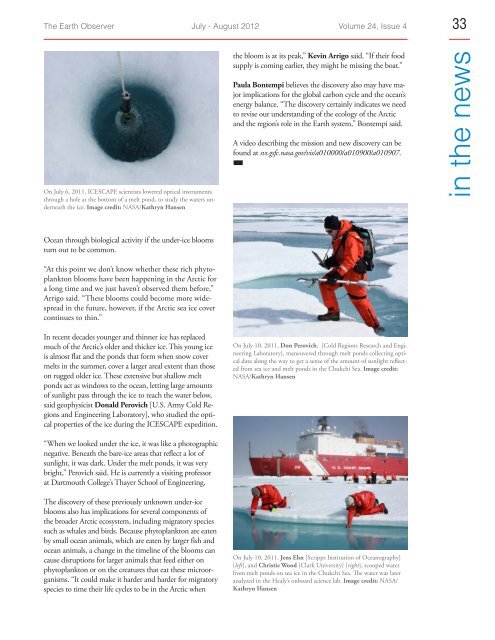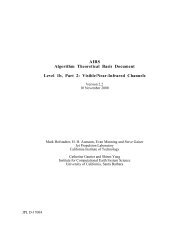Download - NASA's Earth Observing System
Download - NASA's Earth Observing System
Download - NASA's Earth Observing System
Create successful ePaper yourself
Turn your PDF publications into a flip-book with our unique Google optimized e-Paper software.
The <strong>Earth</strong> Observer July - August 2012 Volume 24, Issue 4 33<br />
On July 6, 2011, ICESCAPE scientists lowered optical instruments<br />
through a hole at the bottom of a melt pond, to study the waters underneath<br />
the ice. Image credit: NASA/Kathryn Hansen<br />
the bloom is at its peak,” Kevin Arrigo said. “If their food<br />
supply is coming earlier, they might be missing the boat.”<br />
Paula Bontempi believes the discovery also may have major<br />
implications for the global carbon cycle and the ocean’s<br />
energy balance. “The discovery certainly indicates we need<br />
to revise our understanding of the ecology of the Arctic<br />
and the region’s role in the <strong>Earth</strong> system,” Bontempi said.<br />
A video describing the mission and new discovery can be<br />
found at svs.gsfc.nasa.gov/vis/a010000/a010900/a010907.<br />
••<br />
in the news<br />
Ocean through biological activity if the under-ice blooms<br />
turn out to be common.<br />
“At this point we don’t know whether these rich phytoplankton<br />
blooms have been happening in the Arctic for<br />
a long time and we just haven’t observed them before,”<br />
Arrigo said. “These blooms could become more widespread<br />
in the future, however, if the Arctic sea ice cover<br />
continues to thin.”<br />
In recent decades younger and thinner ice has replaced<br />
much of the Arctic’s older and thicker ice. This young ice<br />
is almost flat and the ponds that form when snow cover<br />
melts in the summer, cover a larger areal extent than those<br />
on rugged older ice. These extensive but shallow melt<br />
ponds act as windows to the ocean, letting large amounts<br />
of sunlight pass through the ice to reach the water below,<br />
said geophysicist Donald Perovich [U.S. Army Cold Regions<br />
and Engineering Laboratory], who studied the optical<br />
properties of the ice during the ICESCAPE expedition.<br />
“When we looked under the ice, it was like a photographic<br />
negative. Beneath the bare-ice areas that reflect a lot of<br />
sunlight, it was dark. Under the melt ponds, it was very<br />
bright,” Perovich said. He is currently a visiting professor<br />
at Dartmouth College’s Thayer School of Engineering.<br />
The discovery of these previously unknown under-ice<br />
blooms also has implications for several components of<br />
the broader Arctic ecosystem, including migratory species<br />
such as whales and birds. Because phytoplankton are eaten<br />
by small ocean animals, which are eaten by larger fish and<br />
ocean animals, a change in the timeline of the blooms can<br />
cause disruptions for larger animals that feed either on<br />
phytoplankton or on the creatures that eat these microorganisms.<br />
“It could make it harder and harder for migratory<br />
species to time their life cycles to be in the Arctic when<br />
On July 10, 2011, Don Perovich, [Cold Regions Research and Engineering<br />
Laboratory], maneuvered through melt ponds collecting optical<br />
data along the way to get a sense of the amount of sunlight reflected<br />
from sea ice and melt ponds in the Chukchi Sea. Image credit:<br />
NASA/Kathryn Hansen<br />
On July 10, 2011, Jens Ehn [Scripps Institution of Oceanography]<br />
[left], and Christie Wood [Clark University] [right], scooped water<br />
from melt ponds on sea ice in the Chukchi Sea. The water was later<br />
analyzed in the Healy’s onboard science lab. Image credit: NASA/<br />
Kathryn Hansen







